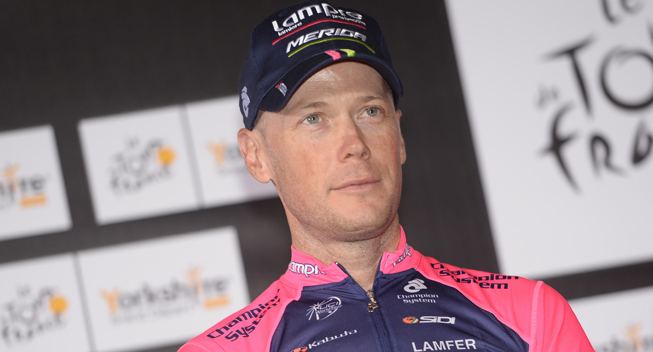Chris Horner’s Lampre team came back from their recovery ride to throngs f media waiting to talk to the American and defending Vuelta a Espana champion, only to find he was not there.
Horner had ridden for longer, in order to process the news that he would not be allowed to start his title defence due to having low cortisol levels, and his team being MPCC members, ruled him out.
“I found out this morning, so I went out and rode my bike for six hours,” Horner said. “It’s the best thing to do. It clears the head. It’s where I feel most comfortable, either riding my bike or hanging out with my wife. For me, the best thing to do was to ride six hours. It’s a great day. The countryside is fantastic. … If you had spoken to me this morning, it would have been a bit ugly. When you’re out training six hours, you realize life is not that bad.”
Horner could have raced under UCI rules and WADA rules, but the much more severe MPCC rules kept him out, something that Horner says he accepts and understands.
“We understand the rules; we respect the rules. This is unfortunate for me. The Vuelta was a big objective for me. I worked and trained to be here. I suffered through the Tour and Utah. I suffered with breathing at the Tour and Utah, so the only option left was with the medication,” Horner said, explaining how two rounds of antibiotics was unable to break his chest infection.
“After the Tour, with my doctor in Oregon, with agreement of the team doctors, we decided that oral cortisone was the only treatment left to clear up the sickness in my lungs,” he continued. “I didn’t want to come here with the same sickness I had at the Tour, and we took every legal medication we could … the problem was with the cortisol level going too low.”
Horner also said he knew there was a possibility he might not be able to start the race. His low levels were caused by treatment taken to stop his bronchitis, which he has had since before the Tour de France.
“Every ‘I’ and ‘T’ was crossed, with the UCI, with the team, every substance I took was legal, every substance I took was approved … I did know, and I was completely aware, that there could be a problem,” he said.
“It’s frustrating as a rider. I knew the risk with the medication, but it was the only way to be healthy,” he said. “Those are the rules. I don’t disagree with the rules. I knew the risk taking the oral cortisone. I had my fingers crossed, and that I wouldn’t have any problems, but with the health checks, it wasn’t possible.”
Horner can return to racing as soon as his cortisol levels go back to normal, which could be in just a few days at the Canadian one-day races. Theo Bos, Belkin’s sprinter, had the exact same problem last year.
“This is one more blow on the chin. I am really disappointed [not] to be racing here against guys like Froome and Contador. I was really looking forward to that,” Horner said shaking his head.
“It’s been a long, trying season. The Tour was incredibly hard,” he continued. “I was hoping to be here at a 100 percent, but clearly I am not. There is nothing more I can do. I did everything right, with training, diet, commitment, but it’s just not meant to be. I have to move on.”
Out of Horner’s misery comes a dream story for his replacement. 21-year-old Italian neo-pro Valerio Conti will now get to wear the number 1 bib in his debut Grand Tour.
| Alvaro GONZALEZ DE GALDEANO ARANZABAL 55 years | today |
| Volodymyr GOMENIUK 40 years | today |
| Ross EDGAR 42 years | today |
| Shern Mun Benedict LEE 30 years | today |
| Immanuel D'ANIELLO 23 years | today |
© CyclingQuotes.com









